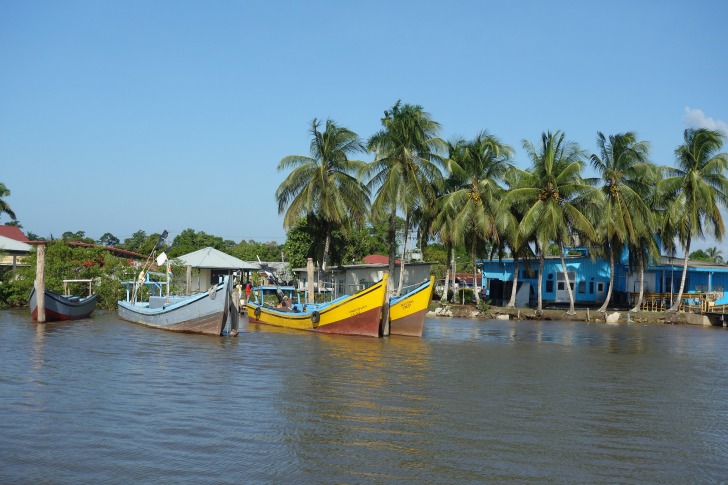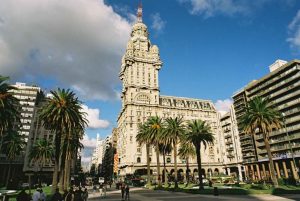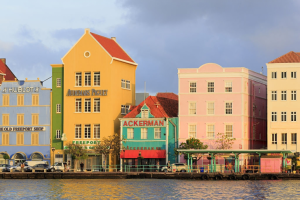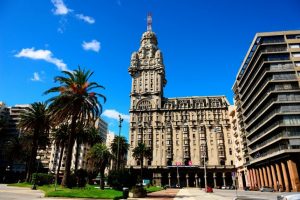Suriname is a South American country that has a unique past.
Europeans arrived in the area in the 16th century, which led to control by the Dutch for over 300 years.
This distinctive history accounts for the fact that Suriname is the only sovereign nation that has Dutch as the official language without being on the European continent.
Suriname’s location at the northern edge of South America and just north of the Equator means it is a lush, tropical environment.
Most of the country – the smallest sovereign state in South America – live in or near the capital city of Paramaribo, which is situated on the Atlantic coast.
Warnings & Dangers in Suriname

OVERALL RISK: MEDIUM
The tourism industry in Suriname is not regulated consistently. Safety inspections are not performed with any regularity, so great caution should be exercised when looking for tour companies that operate excursions. Within the city of Paramaribo, there is better public safety, but caution should still be exercised in different areas of the city, and when dealing with local tour experiences.

TRANSPORT & TAXIS RISK: MEDIUM
Moving around Suriname and its principal cities should only be done during the daytime since crime rates increase after the sun goes down. Public transportation is available, but schedules are spotty and the condition of government-run buses may not be what you are used to back home. Try to avoid getting on already crowded buses as this can increase the risk of being pickpocketed. Have a clear understanding of where the bus is going and the fees involved. Taxis may be a faster option, but be sure to negotiate rates and tips ahead of time to avoid being scammed by an unscrupulous driver. Always select a taxi with seat belts, and use them! If you plan to do a fair amount of traveling, ask your travel agent or planner if hiring a dedicated driver is an option.

PICKPOCKETS RISK: MEDIUM
Like most tourism areas in larger cities, staying aware of your surroundings and not becoming distracted by people or events around you will help protect you from pickpockets. In Suriname, many natives will tell you to be wary, but as long as you stick to sightseeing during daylight hours and remain focused on your destination, you shouldn't have any trouble. Also, be sure not to carry extra cash or unnecessary valuables with you.

NATURAL DISASTERS RISK: LOW
Depending on the time of year you visit Suriname, there is a low risk of experiencing a natural disaster. The risk of earthquakes is low, but during the rainy season, there may be heavy rains and coastal flooding. Because the capital city is located on the Atlantic coast, there is also a risk of hurricanes impacting the area.

MUGGING RISK: MEDIUM
A higher risk of being the victim of a crime in Suriname exists when traveling outside the capital city of Paramaribo. However, even within the city, it is recommended that visitors not wear expensive jewelry or carry large amounts of cash on them. Caution should be exercised when using ATMs or traveling by car and leaving packages in a vehicle unattended.

TERRORISM RISK: LOW
There have been no recent terrorist concerns. In July 2017, a possible terrorist attack against the US embassy was stopped before occurring and two Dutch-Surinamese people were deported. A group of former rebels called The Jungle Commando was disbanded in the late 1980s and early 1990s. There are no indications of probable terrorist acts against the country's civilians.

SCAMS RISK: LOW
While tourism in Suriname was increasing pre-pandemic, the risk of being a victim of scams has not increased. Like any foreign travel destination, visitors should make every effort to use reputable tour organizers for excursions, and the farther ahead these can be planned, the better. Make sure you clearly understand any fees for local transportation. For more involved excursions that may take you out of the major cities, particularly if you plan to travel to the country's interior rain forests, booking with an official and approved company is advised.

WOMEN TRAVELERS RISK: MEDIUM
Suriname as a country is not a particularly tourist-focused location, and this is even more true for women who travel solo. To make the most of a visit to this lush rainforest location, there are some common sense ways to make the trip safer for female travelers. Planning to select accommodations in a good part of the city you're visiting is a start. Paying a little more money for a safe hotel is worth it. Even if the hotel is located in the best part of town, you'll still want to avoid traveling at night. Keep your valuables, including your smartphone, close to you at all times. Don't walk around distracted or displaying expensive accessories (this also includes your phone). Dress modestly and appropriately for the activities you are doing.

TAP WATER RISK: HIGH
Once outside the capital city, water treatment is not uniformly performed on water sources in the country, so drinking tap water is not advised. Even in Paramaribo, it may be best to avoid ice as it may be made with untreated water. For drinking, it is best to stick to bottled water or other bottled beverages.
Safest Places to Visit in Suriname
Paramaribo is the only true city in Suriname and offers the most safety along with an array of activities.
This UNESCO world heritage site is known for its architecture influenced by its Dutch history.
Many of the colonial buildings dating back to the 17th century.
While it is important to remain vigilant in any tourist location, the capital city also has more services for tourists and areas just outside the city with additional points of interest.
One such place is Nieuw Amsterdam, a suburb of Paramaribo that houses a local museum in a former fort located where the Suriname and Commewijne rivers meet.
Places to Avoid in Suriname
If you plan to go off the beaten path in Suriname, exercise caution.
If you are working with reputable travel companies and can stay aware of your situation, you shouldn’t need to avoid any specific areas.
Do check with the US Embassy if you are traveling outside the major population areas and want to be updated on any local issues.
Plan your travel during the day and do your homework.
Safety Tips for Traveling to Suriname
- Eat. Like any tropical paradise with ocean exposure, there are a lot of fabulous foods to try. Just take into consideration the safety and sanitary operations wherever you go. It’s better to have fruit that has not been cut, so you can be sure to wash it and cut it yourself. Also, consider packing some snacks to bring with you. This can help you ease into the local cuisine to keep from upsetting your digestion, and also provide a way to avoid hunger during any local excursions.
- Drink. Be careful when drinking local water, and opt for bottled water whenever possible. Do take advantage of the local abundance of fruit juices, but find a place that will squeeze them fresh for you when ordered.
- Be merry. Activities at night should be avoided as the atmosphere in many locations changes after dark. While enjoying local cultural festivals is a great idea, don’t over-indulge in alcohol, so you can avoid losing your bearings and making unsafe choices.
- Dress for success. This warm, humid, rainforest climate requires the right wardrobe. Dress modestly and leave the flashy jewelry and accessories at home. You don’t want to advertise yourself as a potential mugging victim. In some areas, you will also want to have protection against bug bites (which can transmit several diseases), so bringing some insect repellants and netting is a good idea.
- Stay hydrated. A hot and humid climate requires that you stay hydrated. Try to avoid strenuous activities like hiking or biking during the hottest times of the day.
- Find an expert to trust and trust experts. The best way to stay safe and enjoy yourself is to hire a reputable travel guide who knows the area. Don’t hire spur-of-the-moment guides.
- Mind your money. If you have US dollars with you, you may be able to exchange them for local currency. Not all ATMs take international cards, but if you find one that does, only withdraw money when you feel safe in your surroundings. Remain vigilant and aware whenever withdrawing money from an ATM. Many locations do not accept credit cards, so don’t carry more cash than needed and consider a money belt or other ways to carry cash that is safer.
- Learn the language. Knowing a few key phrases in the country’s native Dutch will help you negotiate prices and avoid getting scammed.
- Respect the culture. Be mindful of the local sites you visit. If you are unsure about taking photos, just ask if this is appropriate.
- Shop but stay aware. If you are drawn to the bargains of large shopping areas, just remember to do all the things that will make your trip enjoyable: keep your money secure, don’t let others distract you, and try to avoid densely packed areas.
So... How Safe Is Suriname Really?
Suriname is a more out-of-the-way place than many more popular tourist destinations, so staying safe there requires a little more work.
By doing some additional planning, working with reputable travel partners, and remaining aware during your stay, there is no reason to worry about your safety during a trip.
If you can follow some common sense principles, you will have a unique and exciting stay in Suriname.
How Does Suriname Compare?
| Country | Safety Index |
|---|---|
| Suriname | 62 |
| Morocco | 54 |
| Qatar | 84 |
| United Arab Emirates | 79 |
| Montenegro | 70 |
| Denmark | 94 |
| Poland | 84 |
| Lithuania | 79 |
| Argentina | 70 |
Useful Information

Visas
Visitors should plan to acquire an e-tourist visa or card before their trip. This can be completed online at the Suriname e-Visa website.

Currency
The Suriname Dollar (SRD) is the official currency of the country. You can exchange US dollars for the SRD at banks in the area, at an exchange rate of roughly one-half SRD to a USD.

Weather
Its proximity to the equator should tell you that the year-round tropical climate is warm, humid, and includes a lot of precipitation.

Airports
Johan Adolf Pengel International Airport is the country's international airport, located about 45 kilometers (or about 28 miles) southwest of the city of Paramaribo. You'll need a taxi, bus, or private transportation to get to the city. Negotiate the transportation fee before leaving. Many airport taxis take Euros but confirm this first.

Travel Insurance
Contact your travel advisor about purchasing travel insurance for a trip to Suriname. As a more remote location that requires a significant commitment of time and money to travel there, travel insurance could help avoid issues if there are travel delays or things that don't go as planned.
Suriname Weather Averages (Temperatures)
Average High/Low Temperature
| Temperature / Month | Jan | Feb | Mar | Apr | May | Jun | Jul | Aug | Sep | Oct | Nov | Dec |
|---|---|---|---|---|---|---|---|---|---|---|---|---|
| High °C | 30 | 30 | 30 | 31 | 31 | 31 | 31 | 32 | 33 | 33 | 32 | 31 |
| Low °C | 24 | 24 | 24 | 25 | 24 | 24 | 24 | 25 | 25 | 25 | 25 | 24 |
| High °F | 86 | 86 | 86 | 88 | 88 | 88 | 88 | 90 | 91 | 91 | 90 | 88 |
| Low °F | 75 | 75 | 75 | 77 | 75 | 75 | 75 | 77 | 77 | 77 | 77 | 75 |












Very helpful site
I found this site very helpful. Not trying to sell me anything, just good, sound information.